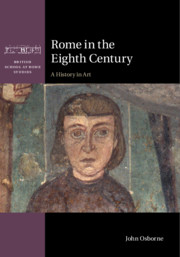Book contents
- Rome in the Eighth Century
- British School at Rome Studies
- Rome in the Eighth Century
- Copyright page
- Contents
- Figures
- Plates
- Acknowledgements
- Abbreviations
- Preface
- 1 Rome in 700: ‘Constantinople on the Tiber’
- 2 Pope John VII servus sanctae Mariae
- 3 Clerics, Monks and Pilgrims
- 4 ‘The City of the Church’
- 5 The Chapel of Theodotus in Santa Maria Antiqua
- 6 Pope Zacharias and the Lateran Palace
- 7 Rome and the Franks
- 8 Paul I
- 9 Hadrian I dux Dei
- 10 Leo III and Charlemagne
- Afterword
- Bibliography
- Index
- Plate Section
3 - Clerics, Monks and Pilgrims
Published online by Cambridge University Press: 11 June 2020
- Rome in the Eighth Century
- British School at Rome Studies
- Rome in the Eighth Century
- Copyright page
- Contents
- Figures
- Plates
- Acknowledgements
- Abbreviations
- Preface
- 1 Rome in 700: ‘Constantinople on the Tiber’
- 2 Pope John VII servus sanctae Mariae
- 3 Clerics, Monks and Pilgrims
- 4 ‘The City of the Church’
- 5 The Chapel of Theodotus in Santa Maria Antiqua
- 6 Pope Zacharias and the Lateran Palace
- 7 Rome and the Franks
- 8 Paul I
- 9 Hadrian I dux Dei
- 10 Leo III and Charlemagne
- Afterword
- Bibliography
- Index
- Plate Section
Summary
Examines three groups of ‘consumers’ of visual culture in the opening decades of the eighth century: clerics (non-papal actors), monks, and pilgrims. Three case studies are employed: the recently discovered mural in the narthex of the church of Santa Sabina, the murals from the excavations of the monastery of San Saba, and the mural placed at the tomb of Pope Cornelius in the Catacomb of San Callisto on the Via Appia. These all offer additional evidence for the pervasive presence of ‘Mediterranean’/Byzantine culture.
- Type
- Chapter
- Information
- Rome in the Eighth CenturyA History in Art, pp. 67 - 87Publisher: Cambridge University PressPrint publication year: 2020

